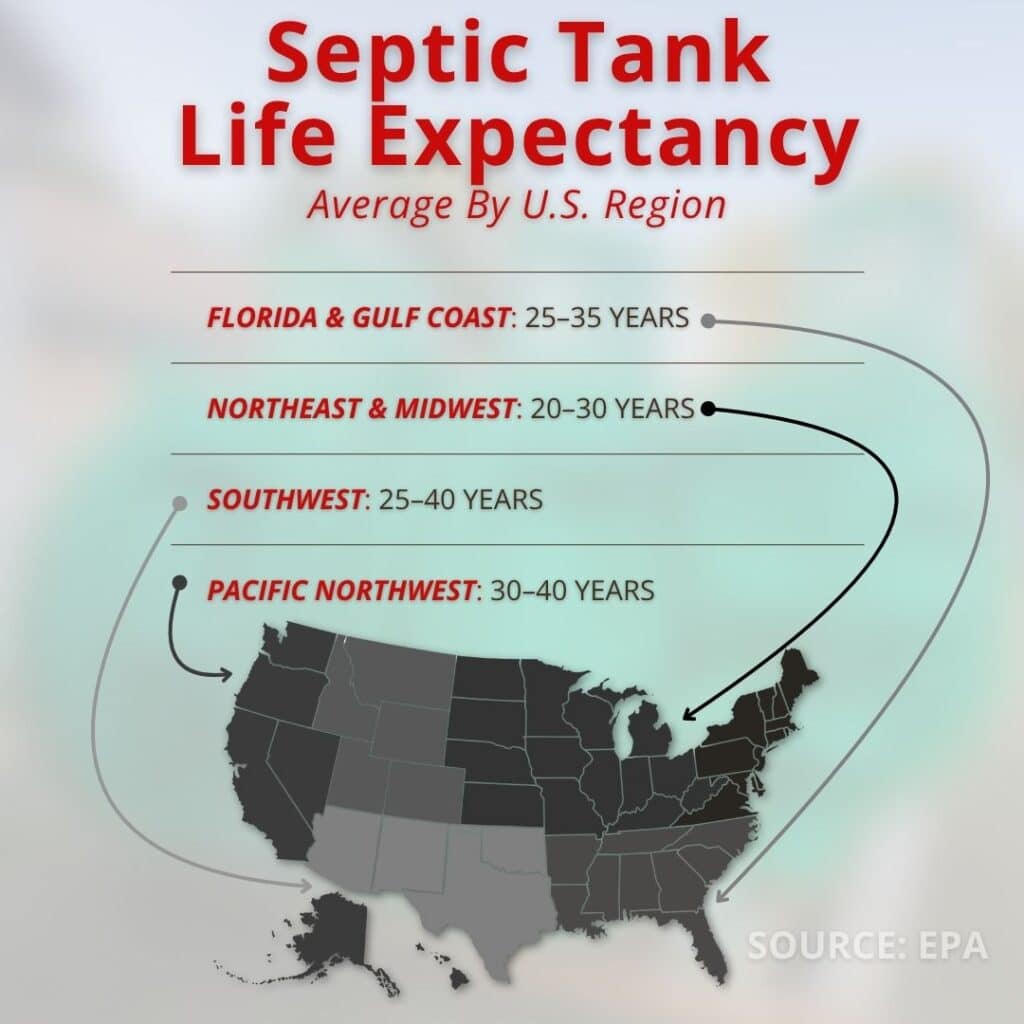Average Lifespan of a Septic Tank
According to the U.S. Environmental Protection Agency (EPA), the average lifespan of a well-maintained septic system is 15 to 40 years. That range varies significantly based on materials, maintenance, and environmental exposure.
|
Tank Material |
Average Lifespan |
Maintenance Level |
Common Issues |
|
Concrete |
30–40 years |
Moderate |
Cracking from soil movement or acidic groundwater |
|
Fiberglass |
25–35 years |
Low |
Shifting in unstable soil, seam separation |
|
Plastic (Polyethylene) |
20–30 years |
Low |
Structural warping, lightweight movement in saturated soil |
|
Steel |
15–20 years |
High |
Corrosion, leaks, rust-through over time |
Concrete and fiberglass tanks are the most common in Florida because they resist corrosion and can handle high water tables better than steel options.

How Climate Affects Septic Tank Lifespan
While material and installation matter, climate is one of the strongest environmental factors determining how long septic tanks last. Different regions put unique stresses on the tank, drain field, and surrounding soil.
Hot and Humid Climates (Florida, Gulf Coast, Southeast)
In places like Tampa Bay, the combination of heat, humidity, and heavy rainfall creates ideal conditions for faster biological activity in the septic tank, which can be both good and bad.
Pros:
- Warm temperatures promote healthy bacterial breakdown of waste.
- Tanks rarely freeze or require cold-weather maintenance.
Cons:
- Heavy rain saturates the soil, reducing the drain field absorption.
- Flooding increases the risk of groundwater entering the system.
- Corrosion and algae growth occur faster in humid conditions.
According to Florida’s Department of Environmental Protection (FDEP), the state has over 2.6 million septic systems, many of which are affected by rising groundwater levels. That means climate-related issues like flooding or soil saturation are more common than mechanical failure.
Cold and Frozen Climates (Northern U.S., Midwest)
In northern regions, cold winters can slow bacterial activity and freeze parts of the system if not insulated correctly. Septic tanks in these climates can last just as long, but only when buried deep enough to stay above freezing.
Challenges include:
- Frozen pipes or drain lines.
- Reduced bacterial activity in low temperatures.
- Slower waste breakdown and higher pumping frequency.
Dry and Arid Climates (Southwest, Desert Regions)
Dry climates experience less water infiltration, which helps prevent flooding but can lead to soil compaction or clogging if the drain field dries out completely.
Typical issues:
- Cracked drain lines from shifting dry soil.
- Limited soil bacteria from a lack of moisture.
- Overload from sudden heavy water use after dry periods.
Florida’s Unique Septic System Challenges
Florida’s subtropical climate means systems are exposed to constant moisture, high groundwater levels, and sandy soils that drain quickly but can erode easily. The University of Florida IFAS Extension notes that these conditions make maintenance and inspection frequency more critical than in cooler regions.
Key climate-related concerns in the Tampa Bay area:
- High rainfall totals: The area averages more than 50 inches of rain per year, which can saturate the drain field and reduce wastewater filtration efficiency.
- Soil composition: Sandy soils allow for fast drainage but are more prone to leaching, which can affect groundwater quality if the system fails.
- Shallow water tables: Some neighborhoods in Hillsborough and Pinellas Counties have groundwater just a few feet below the surface, increasing the risk of tank intrusion.
- Hurricane season: Heavy stormwater flow can overwhelm poorly maintained systems and lead to backflow or surface discharge.
Regular pumping, inspections, and professional monitoring are essential to protect against these regional issues.
Factors That Affect Septic Tank Longevity Anywhere
Beyond climate, several universal factors determine how long your system will last.
1. Maintenance Routine
Septic tanks that are inspected and pumped every 3 to 5 years can last decades longer than neglected systems. Regular maintenance prevents solid waste from clogging the drain field, which is often the most expensive component to replace.
2. Household Water Use
High water usage shortens system lifespan. The EPA
reports that the average American family uses over 300 gallons of water per day. Spreading out laundry loads, fixing leaks, and using low-flow fixtures reduce stress on the tank and drain field.
3. Soil and Ground Conditions
Dense clay or poorly draining soils limit absorption, causing standing water and system strain. Sandy soils drain faster but require careful monitoring to prevent nutrient leaching.
4. Chemical and Product Use
Avoiding harsh chemicals helps preserve bacterial balance. Septic-safe cleaners and limited use of bleach support waste breakdown and prevent long-term damage to the tank and drain field.
5. Installation Quality
Properly sized and installed septic tanks are more efficient and last longer. Tanks installed too shallow or on uneven terrain experience structural stress and shifting, especially during floods or soil erosion events.
Extending the Life of Your Septic System
Even in a humid region like Tampa Bay, you can take practical steps to keep your septic tank running efficiently and lasting longer.
1. Pump and Inspect Regularly
Schedule professional pumping every three to five years, depending on household size and tank capacity. A technician will measure sludge and scum levels, inspect the baffles, and check for leaks.
2. Protect the Drain Field
Keep vehicles, heavy equipment, and storage sheds off your drain field. Compacted soil limits absorption and shortens system life. Plant shallow-rooted grass or ground cover instead of deep-rooted shrubs or trees nearby.
3. Manage Rainwater Flow
Florida’s storms can overwhelm a drain field. Install gutter extensions or drainage swales that redirect roof runoff away from the septic area. Tampa Bay Septic often recommends integrating small landscape berms or gravel trenches to prevent ponding.
4. Watch What Goes Down the Drain
Avoid flushing items like wipes, paper towels, or grease. Even products labeled “flushable” can clog pipes or add unnecessary strain. The Water Environment Federation estimates that wipes contribute to over $440 million in annual sewer and septic damage costs across the United States.
5. Schedule Periodic Professional Inspections
Professional septic inspections identify small issues like cracked lids, tree root intrusion, or drain field saturation before they escalate. Tampa Bay Septic’s team uses specialized tools such as cameras and soil probes to catch problems early.

Assessing Cost For Replacement and Repair
Understanding costs helps you plan for maintenance or upgrades before total failure occurs.
|
System Component |
Average Cost (Florida) |
Typical Lifespan |
|
Concrete Tank Replacement |
$3,500 – $8,000 |
30–40 years |
|
Drain Field Replacement |
$4,000 – $10,000 |
20–30 years |
|
Pump or Effluent Motor Repair |
$300 – $1,200 |
10–15 years |
|
Full System Installation |
$10,000 – $25,000 |
25–40 years |
Cost data from HomeGuide and the Florida Department of Health
When to Call a Professional
If you notice slow drains, gurgling sounds, or damp areas in your yard, those are early warning signs that your system may be struggling. In Florida, symptoms can appear after extended rainy periods when the ground is already saturated.
Call Tampa Bay Septic if you experience:
- Pooling or standing water above your drain field
- Strong odors around your yard or plumbing vents
- Toilets backing up after storms
- Lush green grass patches over your septic area (indicating leaks)
Our technicians provide full system inspections, pumping, and repairs tailored to the challenges of Florida’s humid climate and sandy soil conditions. We also offer preventive maintenance plans to help you extend your system’s life safely and affordably.
Related Questions Homeowners Ask
Does heavy rain damage septic systems?
Yes. Prolonged rain saturates the soil and prevents the drain field from absorbing wastewater properly. Redirecting stormwater away from your septic area is critical.
Is there a best time of year to pump a septic tank?
Spring or early fall are ideal, especially before Florida’s heavy rain season. Pumping before storms ensures your system operates efficiently when groundwater is high.
Can septic tanks last longer than 40 years?
In rare cases, yes. Systems that are pumped routinely, installed on stable soil, and protected from surface runoff can exceed the 40-year mark.
Do I need a septic inspection when buying a home?
Absolutely. Florida’s regulations often require an inspection for property transfers involving septic systems. It helps uncover hidden issues and ensures the system meets local environmental standards.
Conclusion
Climate plays a significant role in how long septic tanks last. In warm, humid regions like Tampa Bay, consistent maintenance, proper drainage management, and routine inspections are essential to keep your system working efficiently.
If you are unsure about your septic system’s age or condition, contact Tampa Bay Septic. Our experienced team provides complete maintenance, repair, and inspection services designed for Florida’s unique environment. With the right care, your septic system can continue protecting your home and property for decades.
